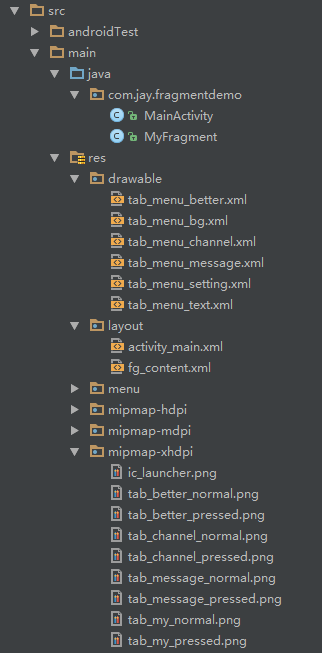本节引言:
在上一节中我们对Fragment进行了一个初步的了解,学习了概念,生命周期,Fragment管理与Fragment事务,以及动态与静态加载Fragment。从本节开始我们会讲解一些Fragment在实际开发中的一些实例!而本节给大家讲解的是底部导航栏的实现!而基本的底部导航栏方法有很多种,比如全用TextView做,或者用RadioButton,又或者使用TabLayout + RadioButton,当然复杂的情况还是得走外层套布局的方法!本节我们用TextView来做一个底部导航栏的效果,也熟悉下Fragment的使用!好的,开始本节内容!
1.要实现的效果图以及工程目录结构:
先看看效果图吧:

接着看看我们的工程的目录结构:

2.实现流程:
Step 1:写下底部选项的一些资源文件
我们从图上可以看到,我们底部的每一项点击的时候都有不同的效果是吧!我们是通过是否selected来判定的!我们要写的资源文件有:首先是图片,然后是文字,接着是背景!
图片Drawable资源:tab_menu_channel.xml
<?xml version="1.0" encoding="utf-8"?><selector xmlns:android="https://schemas.android.com/apk/res/android"> <item android:drawable="@mipmap/tab_channel_pressed" android:state_selected="true" /> <item android:drawable="@mipmap/tab_channel_normal" /></selector>
其他三个照葫芦画瓢!
文字资源:tab_menu_text.xml
<?xml version="1.0" encoding="utf-8"?><selector xmlns:android="https://schemas.android.com/apk/res/android"> <item android:color="@color/text_yellow" android:state_selected="true" /> <item android:color="@color/text_gray" /></selector>
背景资源:tab_menu_bg.xml
<?xml version="1.0" encoding="utf-8"?><selector xmlns:android="https://schemas.android.com/apk/res/android"> <item android:state_selected="true"> <shape> <solid android:color="#FFC4C4C4" /> </shape> </item> <item> <shape> <solid android:color="@color/transparent" /> </shape> </item></selector>
Step 2:编写我们的Activity布局
activity_main.xml:
<RelativeLayout xmlns:android="https://schemas.android.com/apk/res/android" xmlns:tools="https://schemas.android.com/tools" android:layout_width="match_parent" android:layout_height="match_parent" tools:context=".MainActivity"> <RelativeLayout android:id="@+id/ly_top_bar" android:layout_width="match_parent" android:layout_height="48dp" android:background="@color/bg_topbar"> <TextView android:id="@+id/txt_topbar" android:layout_width="match_parent" android:layout_height="match_parent" android:layout_centerInParent="true" android:gravity="center" android:textSize="18sp" android:textColor="@color/text_topbar" android:text="信息"/> <View android:layout_width="match_parent" android:layout_height="2px" android:background="@color/div_white" android:layout_alignParentBottom="true"/> </RelativeLayout> <LinearLayout android:id="@+id/ly_tab_bar" android:layout_width="match_parent" android:layout_height="56dp" android:layout_alignParentBottom="true" android:background="@color/bg_white" android:orientation="horizontal"> <TextView android:id="@+id/txt_channel" android:layout_width="0dp" android:layout_height="match_parent" android:layout_weight="1" android:background="@drawable/tab_menu_bg" android:drawablePadding="3dp" android:drawableTop="@drawable/tab_menu_channel" android:gravity="center" android:padding="5dp" android:text="@string/tab_menu_alert" android:textColor="@drawable/tab_menu_text" android:textSize="16sp" /> <TextView android:id="@+id/txt_message" android:layout_width="0dp" android:layout_height="match_parent" android:layout_weight="1" android:background="@drawable/tab_menu_bg" android:drawablePadding="3dp" android:drawableTop="@drawable/tab_menu_message" android:gravity="center" android:padding="5dp" android:text="@string/tab_menu_profile" android:textColor="@drawable/tab_menu_text" android:textSize="16sp" /> <TextView android:id="@+id/txt_better" android:layout_width="0dp" android:layout_height="match_parent" android:layout_weight="1" android:background="@drawable/tab_menu_bg" android:drawablePadding="3dp" android:drawableTop="@drawable/tab_menu_better" android:gravity="center" android:padding="5dp" android:text="@string/tab_menu_pay" android:textColor="@drawable/tab_menu_text" android:textSize="16sp" /> <TextView android:id="@+id/txt_setting" android:layout_width="0dp" android:layout_height="match_parent" android:layout_weight="1" android:background="@drawable/tab_menu_bg" android:drawablePadding="3dp" android:drawableTop="@drawable/tab_menu_setting" android:gravity="center" android:padding="5dp" android:text="@string/tab_menu_setting" android:textColor="@drawable/tab_menu_text" android:textSize="16sp"/> </LinearLayout> <View android:id="@+id/div_tab_bar" android:layout_width="match_parent" android:layout_height="2px" android:background="@color/div_white" android:layout_above="@id/ly_tab_bar"/> <FrameLayout android:layout_width="match_parent" android:layout_height="match_parent" android:layout_below="@id/ly_top_bar" android:layout_above="@id/div_tab_bar" android:id="@+id/ly_content"> </FrameLayout></RelativeLayout>
代码解析:
首先定义顶部标题栏的样式,48dp的LinearLayout中间加上一个TextView作为标题!
接着定义一个大小为56dp的LinerLayout对其底部,在这个里面加入四个TextView,比例1:1:1:1,并且设置相关属性,接着在这个LinearLayout上加一条线段!
最后以标题栏和底部导航栏为边界,写一个FrameLayout,宽高match_parent,用做Fragment的容器!
PS:这里四个TextView属性是重复的,你也可以自行抽取出来,编写一个style,设置下~
Step 3:隐藏顶部导航栏
意外发现以前的在Activity中调用requestWindowFeature(Window.FEATURE_NO_TITLE);可以隐藏手机自带顶部导航栏,但是写demo时候发现会报错,即使这句话写在了setContentView()之前!可能是因为继承的是AppCompatActivity而非Activity类!
当然以前的getSupportActionbar().hide()隐藏掉Actionbar,但是他还是会在界面上!最后还有一种方法就是自己编写一个style,然后在AndroidManifest.xml中为Application设置这个Theme:
注:把 requestWindowFeature(Window.FEATURE_NO_TITLE);放在super.onCreate(savedInstanceState);前面就可以隐藏ActionBar而不报错。
接着AndroidManifest.xml设置下theme属性:
android:theme="@style/Theme.AppCompat.NoActionBar"
PS:上述"良心代码"由好程序员曹神赞助~
Step 4:创建一个Fragment的简单布局与类:
fg_content.xml:
<?xml version="1.0" encoding="utf-8"?><LinearLayout xmlns:android="https://schemas.android.com/apk/res/android" android:orientation="vertical" android:layout_width="match_parent" android:layout_height="match_parent" android:background="@color/bg_white"> <TextView android:id="@+id/txt_content" android:layout_width="match_parent" android:layout_height="match_parent" android:gravity="center" android:text="呵呵" android:textColor="@color/text_yellow" android:textSize="20sp"/></LinearLayout>
MyFragment.java:
/** * Created by Coder-pig on 2015/8/28 0028. */public class MyFragment extends Fragment { private String content; public MyFragment(String content) { this.content = content; } @Override public View onCreateView(LayoutInflater inflater, ViewGroup container, Bundle savedInstanceState) { View view = inflater.inflate(R.layout.fg_content,container,false); TextView txt_content = (TextView) view.findViewById(R.id.txt_content); txt_content.setText(content); return view; }}代码解析:
就是简单的重写了一个onCreateView()方法,其他方法可以按需重写!
Step 5:编写MainActivity.java
先说说我们要考虑的一些关键问题:
- Fragment什么时候初始化和add到容器中?什么时候hide和show?
- 如何让TextView被选中?选中一个TextView后,要做一些什么操作?
- 刚进入MainActivity怎么样让一个TextView处于Selected的状态?
嗯,接下来一一解答上面这些问题:
- 我们选中TextView后对对应的Fragment进行判空,如果为空,初始化,并添加到容器中;而hide的话,我们定义一个方法hide所有的Fragment,每次触发点击事件就先调用这个hideAll方法,讲所有Fragment隐藏起来,然后如果TextView对应的Fragment不为空,我们就将这个Fragment显示出来;
- 这个我们通过点击事件来实现,点击TextView后先重置所有TextView的选中状态为false,然后设置点击的TextView的选中状态为true;
- 这个更简单,我们是通过点击事件来设置选中的,那么在onCreate()方法里加个触发点击事件的方法不就可以了嘛~ txt_channel.performClick();
逻辑都弄懂了,直接上代码咯:
MainActivity.java:
/** * Created by Coder-pig on 2015/8/28 0028. */public class MainActivity extends AppCompatActivity implements View.OnClickListener{ //UI Object private TextView txt_topbar; private TextView txt_channel; private TextView txt_message; private TextView txt_better; private TextView txt_setting; private FrameLayout ly_content; //Fragment Object private MyFragment fg1,fg2,fg3,fg4; private FragmentManager fManager; @Override protected void onCreate(Bundle savedInstanceState) { super.onCreate(savedInstanceState); requestWindowFeature(Window.FEATURE_NO_TITLE); setContentView(R.layout.activity_main); fManager = getFragmentManager(); bindViews(); txt_channel.performClick(); //模拟一次点击,既进去后选择第一项 } //UI组件初始化与事件绑定 private void bindViews() { txt_topbar = (TextView) findViewById(R.id.txt_topbar); txt_channel = (TextView) findViewById(R.id.txt_channel); txt_message = (TextView) findViewById(R.id.txt_message); txt_better = (TextView) findViewById(R.id.txt_better); txt_setting = (TextView) findViewById(R.id.txt_setting); ly_content = (FrameLayout) findViewById(R.id.ly_content); txt_channel.setOnClickListener(this); txt_message.setOnClickListener(this); txt_better.setOnClickListener(this); txt_setting.setOnClickListener(this); } //重置所有文本的选中状态 private void setSelected(){ txt_channel.setSelected(false); txt_message.setSelected(false); txt_better.setSelected(false); txt_setting.setSelected(false); } //隐藏所有Fragment private void hideAllFragment(FragmentTransaction fragmentTransaction){ if(fg1 != null)fragmentTransaction.hide(fg1); if(fg2 != null)fragmentTransaction.hide(fg2); if(fg3 != null)fragmentTransaction.hide(fg3); if(fg4 != null)fragmentTransaction.hide(fg4); } @Override public void onClick(View v) { FragmentTransaction fTransaction = fManager.beginTransaction(); hideAllFragment(fTransaction); switch (v.getId()){ case R.id.txt_channel: setSelected(); txt_channel.setSelected(true); if(fg1 == null){ fg1 = new MyFragment("第一个Fragment"); fTransaction.add(R.id.ly_content,fg1); }else{ fTransaction.show(fg1); } break; case R.id.txt_message: setSelected(); txt_message.setSelected(true); if(fg2 == null){ fg2 = new MyFragment("第二个Fragment"); fTransaction.add(R.id.ly_content,fg2); }else{ fTransaction.show(fg2); } break; case R.id.txt_better: setSelected(); txt_better.setSelected(true); if(fg3 == null){ fg3 = new MyFragment("第三个Fragment"); fTransaction.add(R.id.ly_content,fg3); }else{ fTransaction.show(fg3); } break; case R.id.txt_setting: setSelected(); txt_setting.setSelected(true); if(fg4 == null){ fg4 = new MyFragment("第四个Fragment"); fTransaction.add(R.id.ly_content,fg4); }else{ fTransaction.show(fg4); } break; } fTransaction.commit(); }}3.代码下载:
FragmentDemo.zip:FragmentDemo.zip 下载声明:图片素材来自App:better,本代码只做演示,并无用于商业用途!
4.本节小结
本节给大家讲解了如何使用一个LinarLayout + 四个TextView 实现一个底部导航栏以及Fragment add,hide,show的逻辑~还是蛮简单的,最后要感谢小猪秘密基地的基神,B神,还有好程序员曹神给我的一些指点!万分感谢,仅以此篇纪念小猪重返装逼界,嗯,重返应用层,嘿嘿,本节就到这里,谢谢~





